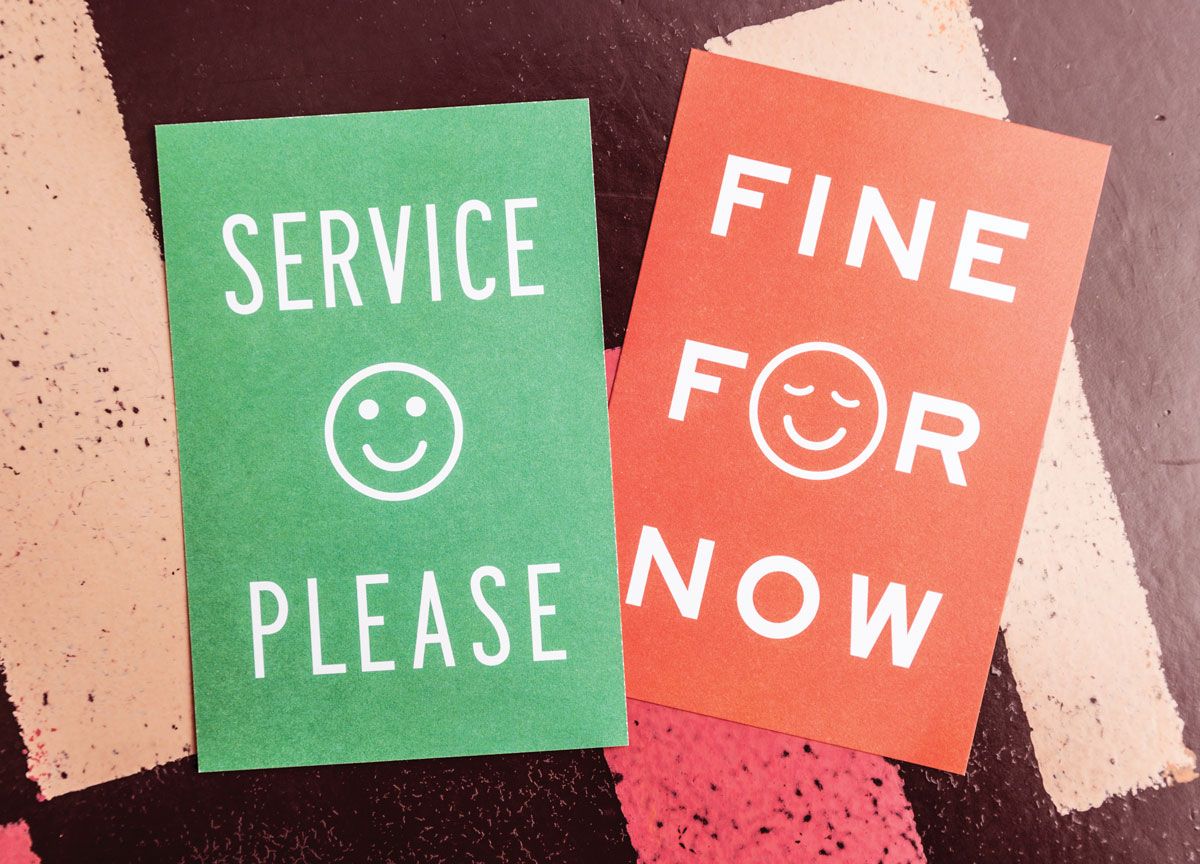
Photograph by Martha Williams
At first glance, the dining room at Iberian Pig in Buckhead appears to be no different these days. The eggplant and gold–hued space, designed by vintage-meets-modern pro Elizabeth Ingram, has the same warm, textured vibe as when the restaurant opened in the spring of 2019. However, upon closer inspection, things have changed. The room still buzzes but more softly, as if someone turned down the volume. Servers donning masks and gloves cautiously flit around stations stocked with hand sanitizer. To limit interactions with servers, guests are given double-sided tokens reminiscent of the ones used at Brazilian steakhouses: One side says “service please”; the other, “fine for now.”

Photograph by Martha Williams
Under the state’s COVID-19 restrictions on in-person dining, restaurants must rearrange or remove tables to ensure social distancing, increase cleaning and sanitization, and require employees who interface with customers to wear masks and gloves. Those rules, which are necessary to save lives, add to the cost of doing business. They also can create a stark and austere dining room—at a time when restaurateurs want guests to feel more comforted than ever.
Of course, for beleaguered restaurants, a total redesign that takes into account these new constraints is out of the question, financially. But many owners are cleverly reimagining their dining rooms to offer as pleasant and safe an experience as possible. “We just try to be creative and not make it look so empty at the same time,” says Tamar Telahun, owner of Feedel Bistro. Telahun didn’t want to strip her intimate dining room of every extraneous table, so she instead spaced out the tables and placed magazines on the ones that can’t be seated with guests. “Then, of course, we’re wearing masks to serve and talk to customers, so that’s just super awkward—they don’t know your expression. I’m always saying, ‘I swear, I’m smiling behind the mask.’”

Photograph by Martha Williams

Photograph by Martha Williams
Some of the changes are subtle. At Morningside’s Whiskey Bird, co-owner Anthony Vipond installed an island in the center of the dining room. Topped with rolled silverware and glasses, as well as plants and candles, it’s both practical for servers and aesthetically pleasing for guests. It was an easy way for Whiskey Bird to get place settings off the table (a state requirement) while also filling some of the emptied-out space where more tables once were.
Because restaurant dining is safer outdoors than inside, restaurants are creating new patio spaces or revamping and expanding the ones they already have. They’re also trying to open up indoor dining rooms to the outdoors as much as possible, to improve airflow while relying less on air conditioning, which can spread the virus. Those adjustments actually work to create a different mood, says John Bencich, founding principal of Square Feet Studio, the design and architecture firm behind such restaurants as Kimball House, Bar Mercado, Watchman’s Seafood and Spirits, and the recently opened Little Bear.
“It’s a little more European, it’s a little more open,” Bencich says. “Everything doesn’t have to be full air-conditioned com- fort all the time. Restaurateurs are doubling down on that.”
One such restaurateur is chef Ronald Hsu, who expanded Lazy Betty’s underutilized covered patio after he realized diners felt safer outside. “We’re doing it on a budget, and a lot of our cooks and servers are now turning into landscape designers and craftsmen and helping us doll it up,” Hsu says. A fresh coat of paint, new outdoor furniture, and the installation of aqua subway tile (left over from the restaurant’s build-out) spruced up the patio. Throw in some planter boxes and bistro lights and you have a mini-oasis on the edge of a parking lot.
At Miller Union, Steven Satterfield worked with prop stylist Thom Driver to
solve the problem of the tables that can’t be occupied by guests: They placed ceramics and arrangements of leafy fronds on them. On the patio, the empty space was filled with planters spilling over with English Ivy and Autumn Fern. The pandemic gave Satterfield a chance to slow down and appreciate how green Atlanta is, and he wanted to bring that joy into his restaurant. “It’s just so lush and beautiful everywhere you look,” he says.
As Telahun points out, a restaurant’s space is about more than decor: It’s people that make a dining room feel vibrant. Since reopening Feedel Bistro, Telahun has found that, despite there being fewer guests by necessity, the conversation is more robust, with diners unwinding on the patio over cocktails for a couple of hours. “We need one another—that warmth from one another—to survive,” she says. “You don’t realize how much you miss people until it’s all gone, right?”
This article appears in our August 2020 issue.













